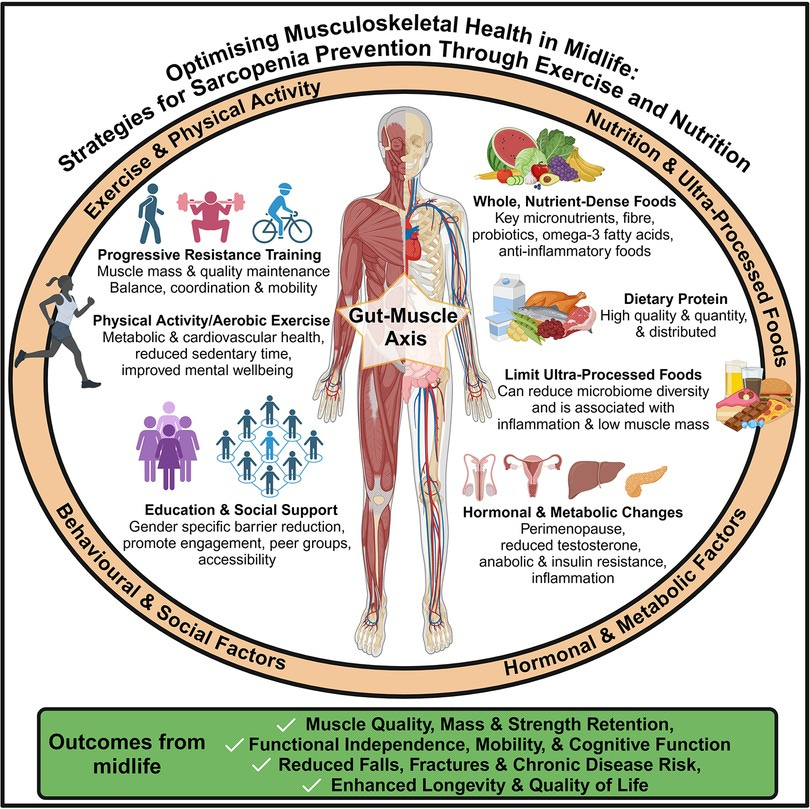Strength First, Not Strength Only: The Full Midlife Muscle Protocol
Training protects muscle. Gut, food, and hormones protect the training.
Most people don’t realize they’re losing muscle—until it’s already compromised.
Sarcopenia is often framed as an “aging” problem. Something we screen for at 70. Something to worry about once function has declined.
But new data says otherwise:
Up to 36% of adults under 60 already meet criteria for low muscle mass.
Let that sink in.
We’re seeing early sarcopenia in people in their 40s and 50s — a group that rarely gets evaluated for strength, power, or lean mass retention. And if we don’t catch it now, we lose the chance to prevent disability later.
Midlife is the tipping point. And we’re missing it.
“Without resistance training, all the protein in the world won’t protect your muscle.”
Protein is important. But it doesn’t work alone.
As we age, muscle protein synthesis becomes less responsive to dietary protein. This is known as anabolic resistance — and it's why we need higher doses of protein and a mechanical trigger (resistance training) to stimulate muscle building.
A 2025 editorial in Frontiers in Sports and Active Living drives this point home:
“High-protein diets had minimal impact on muscle mass and strength in physically active middle-aged adults... reinforcing the need for an integrated approach combining diet and resistance training.”
If your plan is protein without training — it’s incomplete.
If your plan is training without quality protein — you’re leaving gains on the table.
What does early sarcopenia prevention actually look like?
The graphic below from the editorial is worth saving:
It outlines a full-spectrum strategy for preserving muscle during the critical midlife years.
Let’s break it down:
1. Progressive Resistance Training
2–3x/week lifting sessions
Focus on compound movements
Prioritize quality over volume
Muscle mass, balance, and mobility decline faster than most people think. Strength protects all three.
2. Nutrient-Dense Foods & Protein Distribution
Protein target: 1.6–2.2g/kg/day
Distribute intake across meals (not just dinner)
Include anti-inflammatory nutrients (fiber, omega-3s, phytonutrients)
3. Limit Ultra-Processed Foods (UPFs)
UPFs are linked to lower muscle mass
They damage gut diversity and increase inflammation
Swap processed snacks with high-protein yogurt, legumes, minimally processed meals
4. Gut-Muscle Axis
Emerging research is connecting gut health with muscle function, metabolic health, and recovery.
Probiotics, prebiotics, and exercise all support a healthy gut environment that may improve muscle protein synthesis.
5. Hormonal Shifts
Testosterone, estrogen, and insulin sensitivity decline in midlife
Perimenopause is a vulnerable phase for women (with unique barriers to strength training)
Resistance exercise improves hormonal resilience — but we must address access and education gaps too
We need to reframe muscle loss.
It’s not about vanity. It’s about function, resilience, and longevity.
Muscle isn’t just tissue — it’s metabolic armor.
It regulates blood sugar, supports cognition, improves immunity, and reduces injury risk.
And once you lose it, it’s hard to get back.
Muscle loss isn’t just an aging issue.
It’s a midlife priority.
So what’s your plan?
If you're in your 40s or 50s — this is your window.
If you're a clinician — these are the patients we can still help before decline.
Let’s make sarcopenia prevention part of standard midlife care.
Not an afterthought.
Subscribe for more strategies to preserve muscle and metabolic health.
And if this post hit home, share it with someone who’s still focused on fat loss instead of function.
—
Source:
Ispoglou, T., Norton, C., & McCullough, D. (2025). Preventing sarcopenia and promoting musculoskeletal health in middle-aged adults: the role of exercise and nutrition. Frontiers in Sports and Active Living. DOI: 10.3389/fspor.2025.1601326






I was hoping the media would have protested it….thank you for your diligence. Thank you.